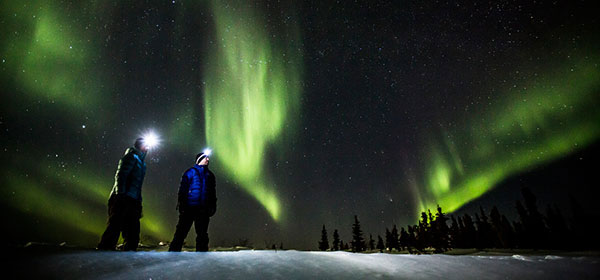Tapping my toes to keep them warm, I lean into the potbelly fireplace in the centre of the tent. I wrap my hands around a mug of tea and breathe in its heat. The clock above the entry reads almost midnight. Around the small room, tourists and locals huddle on timber chairs, expensive camera equipment at the ready by their sides. We’ve all stayed up past bedtime in the hope to witness one of Yukon’s major tourism drawcards – the Aurora Borealis, otherwise known as the Northern Lights.
It’s winter and outside the temperature has dropped to –30°C. But our walled tent is cosy – it’s one of a handful of tents and log cabins on a large snow-covered property, about 20 minutes’ drive north of Yukon’s capital, Whitehorse. The dwellings are reminiscent of those used by trappers and gold prospectors in the 19th century, and are spaced well apart to make one feel truly in the wilderness. The property’s closeness to the city, however, makes it the ideal spot for travellers to sample the Northern Lights on short itineraries, with tourism operator Northern Tales Travel Services.

Yukon Territory is one of the best places in the world to see the Northern Lights, thanks to its proximity to the Arctic Circle and its largely untouched landscape. With large swathes of the territory devoid of the light pollution found in Canada’s southern cities, visitors are almost guaranteed a show in Yukon, as long as the skies are clear. The territory has a reputation for some of the most lively and predictable displays of the lights, and a trip here wouldn’t be complete without staying up to watch the colourful spectacle (the best time to go is from late August to mid-April).
As I venture outside the tent, toward the warmth of a campfire, the buzz of excitement fills the crisp air. Our official aurora watcher is bounding toward us with the news for which we’ve been waiting .
In a large field of snow, I stand in the cold, camera poised on tripod, staring at the sky. Soft streams of the colour lime pulsate high above the tips of pines. Then there’s a boysenberry ripple, a sway of yellow, and more green.

It’s enchanting, peaceful, arresting. I set my camera’s shutter speed, point the lens due north toward the dancing lights, and click away. Enthralled, I quickly forget about the chill in the air. The colours ebb and flow as if they are at the mercy of a tide on an inky ocean. They’re captivating, and I can understand why many are lured to Yukon’s remote corners to be spellbound by Aurora Borealis’ beauty.
The lights surely captivated the imagination of British–Canadian poet Robert Service, who penned the epic The Ballad of the Northern Lights:
“… The skies of night were alive with light, with a throbbing, thrilling flame; amber and rose and violet, opal and gold it came.
“And soft they danced from the polar sky, and swept in primrose haze; and swift they pranced with their silver feet, and pierced with a blinding blaze.”
The writer travelled as a guest of Tourism Yukon and Destination Canada
A travel writer with a background in hard news reporting, Jennifer Ennion searches for the human, environmental and cultural connection in every adventure. As a passionate scuba diver, snowboarder and outdoor enthusiast, she’s always juggling her two loves: the sea and snow. These passions have led to her floating down rapids in Finland, swimming with beluga whales in sub-Arctic Canada, scuba diving with sharks in Australia and snowboarding in the American Rockies.
Related articles:
Five fun things Canada offers
Canada: what’s happening this year

